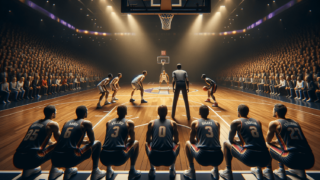
Basketball Substitution Area Rule: When and Where
Written by: Basketball Universe
Last updated:

Welcome to the thrilling world of basketball complexities! Today, we dive deep into the ins and outs of the Basketball Substitution Area Rule: When and Where. So, get ready to enhance your understanding of the game, as we unlock the mysteries surrounding this crucial aspect of basketball that keeps the wheels of player rotation churning seamlessly. With a fun, professional stride, we’ll unravel the subtleties of this rule, ensuring you become a true connoisseur of basketball’s art of substitution!
Basketball Substitution Area Rule: When and Where
In basketball, the Substitution Area Rule governs when and where players can be substituted during the game. Substitutions occur during dead-ball situations or when the ball is out of play, such as after a basket, free throw, or stoppage in play due to a violation or foul. The substitution area is usually marked near the scorer’s table, with the entering player waiting at the designated area until the official beckons them onto the court. This rule ensures smooth player rotations, preventing interruptions during gameplay and maintaining the flow of the game.
The Dynamic Interplay of Basketball Substitutions
Although it may often be overlooked, the art of substitution in basketball significantly impacts the overall strategy and flow of the game. Making the right substitutions at the right time may mean the difference between a clutch victory and a crushing defeat. In this blog post, we’ll explore the intricacies of the Basketball Substitution Area Rule, breaking it down to understand when and where these pivotal changes happen. So, let’s jump right in and unravel this core part of the game that meshes basketball rules with on-the-fly coaching decisions.
The Essentials of the Substitution Rule
The Rule’s Nitty-Gritty
Officially recognized in both FIBA and NBA basketball rules, the Substitution Area Rule serves to ensure seamless player changes during gameplay. A substituting player must follow a specific protocol. Firstly, the player must check-in at the scorer’s table and inform the official scorer of their intent to substitute. The scorer will then notify the referees of the impending substitution.
The Dead-ball Scenario
Substitutions typically occur during dead-ball situations when the play is paused or when the ball is out of play, such as after scoring a basket, a missed free throw with no other attempts, or following a called violation or foul. Additionally, substitutions can be made during timeouts.
Knowing Your Mark: The Substitution Area
The designated substitution area is usually marked on the sidelines, adjacent to the scorer’s table. In NBA games, it is indicated by a four-foot-wide “apron” in front of the scorer’s table, assigned for incoming players. In FIBA games, the official Substitution Box is situated between the scoring table and the team benches, with a size of approximately 80 cm (31.5 inches) wide and 1 meter (39.4 inches) deep. The substituting player should remain in these specific areas until the officials give them the nod to enter the court.
Navigating Substitution Strategies
Mastering the Art of Timing
When it comes to basketball strategy, the timing of substitutions plays a significant role in a team’s performance. Coaches must closely monitor player fatigue, foul trouble, and game situation. Strategic substitutions during critical moments of the game can turn the tide in a team’s favor. Savvy coaches swiftly react to the game’s dynamic ebb and flow, making well-timed rotations to take advantage of specific matchups or counter the opposition’s tactics.
The Sixth Man and Bench Depth
The term “Sixth Man” refers to a team’s first substitute, who is often a top performer off the bench. The Sixth Man plays a vital role in energizing the team and providing an offensive or defensive spark when needed most. A deep bench signifies a team with a strong group of players who can be rotated in to maintain momentum or change the game’s complexion for their team.
Balancing Act: Offensive and Defensive Substitutions
Strategic offensive and defensive substitutions are essential to achieving the proper balance in a team. Coaches might insert an offensive specialist during possessions where a score is needed or bring in a lockdown defender to stop the opponent’s star player in key situations. These tactical substitution decisions can become a psychological chess match between opposing coaches, as they continuously adjust lineups to exploit mismatches and neutralize threats on the court.
Understanding the Rarity of Live-ball Substitutions
Live-ball Substitutions: A Rare Occurrence
While most substitutions occur during dead-ball situations, live-ball substitutions are technically possible but rarely seen in organized basketball. According to FIBA rules, a player can be substituted while the game is live (i.e., no stoppage in play) only in exceptional circumstances, like after an injury or disqualification. In the NBA, live-ball substitutions are not allowed unless explicitly authorized by officials due to extraordinary situations.
Emergencies and Game Flow
In cases where a live-ball substitution becomes necessary, such as an injured player on the court, the referees might blow the whistle to allow the replacement while also showing leniency towards the five-second rule. In turn, the substituting player must be especially quick to check in and enter the substitution area, with the on-court player exiting as fast as possible. This process of quick substitution is vital to maintain the pace of the game for all parties involved – from the players to the fans.
Substitution Rule Violations and Consequences
Illegal Substitutions and Penalties
Entering the game without following specific procedures constitutes an illegal substitution, which may lead to penalties. For FIBA play, a player who enters the court during a live-ball without stopping the clock may be issued a technical foul. In the NBA, an illegal substitution results in a team warning. Subsequent violations then lead to a technical foul. Understanding the rules and consequences of the Basketball Substitution Area ensures that teams avoid unnecessary penalties, which could harm their chances of success during a closely contested game.
Wrap Up on the Substitution Process
As we’ve delved into the world of basketball substitution, it’s clear that the Basketball Substitution Area Rule is crucial in maintaining the game’s continuity while providing coaches with essential strategic options. From mastering the right timing and designated area to the nuanced dance of offensive and defensive specialists, the art of substitution is a vital piece of the grander puzzle that makes the sport of basketball captivating and complex.
Importance of Communication with Officials
Clear communication with officials is crucial for a smooth substitution process. Players and coaches should always notify the official scorer and referees about their intent to substitute so they can make the change at the earliest possible moment. Proper verbal and non-verbal signals, as well as respecting the substitution area, ensure that the game proceeds without any unnecessary interruptions or delays.
Incorporating Substitution Tactics
Shifting Momentum with Substitutions
One strategic use of substitutions is when coaches attempt to shift the game’s momentum in their team’s favor. For example, if the opposing team is on a scoring run or seems to have gained an upper hand, a coach might substitute a player specializing in perimeter defense or interior shot-blocking to disrupt the opposing team’s flow. These tactical changes can help teams regain control of a game, swing momentum, and secure a winning position.
Managing Player Fatigue
Successfully managing player fatigue throughout the match is essential for overall team performance. Skillful coaches recognize the signs of a tired player and know when to make a substitution. Giving players brief respites can help keep them energized for key moments late in the game. By having a rotation of fresh players, a team can sustain its defensive intensity, offensive efficiency, and sharp decision-making – especially during crucial, high-stakes periods of play.
The Impact of Substitutions on Team Chemistry
Building Trust and Confidence with Substitutions
Smart substitution choices also contribute to building trust and confidence among team members. When a coach successfully deploys role players in critical situations, it can boost the team’s overall morale and reinforce the importance of each individual’s contribution. Moreover, as players see that the coach trusts them to deliver in key moments, it helps solidify team chemistry and fosters a collective commitment to winning.
Maintaining a Positive Attitude on the Bench
Substituted players should also understand that the game isn’t all about playing every minute on the court. Staying engaged and positive on the bench tremendously impacts team morale, as they cheer on their teammates and act as de facto assistants helping to spot opposition strategies and player patterns. By maintaining a supportive attitude and staying ready for their next turn on the court, substituted players can make valuable contributions to the team’s overall success.
Now armed with a comprehensive understanding of the Basketball Substitution Area Rule, its impact on the game, and its strategic applications, you have truly expanded your basketball knowledge. Keep this insightful information in mind as you watch your favorite teams and players compete, and appreciate the subtle strategies and intelligence behind the exciting world of basketball substitutions.
Frequently Asked Questions (FAQ) on Basketball Substitution Area Rule
Curious to learn more about the art of substitution in basketball? We’ve compiled a list of the top 10 frequently asked questions and their answers to help you delve even deeper into the fascinating world of basketball substitutions. Take a look!
1. Is there a limit to the number of substitutions allowed in a basketball game?
No, there is no limit to the number of substitutions a team can make in a basketball game. Coaches are free to make as many substitutions as needed, as long as they follow the substitution rules and procedures.
2. Can a substituted player re-enter the game?
Yes, a substituted player can return to the game later, as long as the coach substitutes them during a dead-ball situation or a timeout, and follows the required substitution process.
3. Are there any restrictions in substituting the designated starting players?
There are no restrictions on substituting the designated starting players. Coaches can replace any player on the court, including starting players, according to their game strategy and substitution decisions.
4. What happens if both basketball teams want to substitute players at the same time?
If both teams request to substitute players simultaneously, the officials will give priority to the team on offense. After the offensive substitution is complete, they will then allow the defensive team to make its substitution(s).
5. Can a player be substituted without the coach’s permission?
No, a player can only be substituted with the coach’s explicit permission. The player must receive and follow the coach’s instructions before checking in at the scorer’s table and entering the substitution area.
6. How many players can be substituted at the same time in basketball?
There is no set limit on the number of players that can be substituted simultaneously. However, it is rare to see wholesale changes in basketball, as coaches usually prefer to balance their lineups and maintain a consistent team dynamic on the court.
7. Can a basketball team use a specialized timeout for substitution purposes?
Yes, a team can request a timeout specifically for substitution purposes. During timeouts, coaches can substitute players and discuss strategy, ensuring a smooth rotation while maximizing the effectiveness of the game plan enforcement.
8. Can a substitute enter the game before the player they are replacing has left the court?
No, the substitute must wait until the player they are replacing has exited the court. The officials will then signal the substitute to enter the game, ensuring seamless transitions that do not disrupt gameplay.
9. Is it possible for a player to be on the court without having checked in at the scorer’s table?
Though rare, it is possible but considered a violation. If a player enters the court without having checked in, the team risks an illegal substitution penalty. To avoid this, players should always follow the correct substitution protocol and wait for the official’s signal to enter the game.
10. Does a substitution stop the game clock in basketball?
No, the game clock generally does not stop for substitutions. Substitutions occur during dead-ball situations or timeouts when the game clock is already stopped. However, in rare cases, such as an injury, the referees may stop the game clock temporarily to allow a substitution.
Featured Posts
- No pillar pages found.





